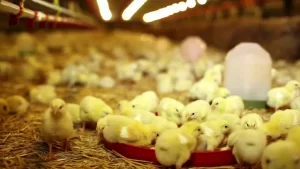Looking for a guide on How to Start a poultry feed mill in Nigeria with a business plan to boot alongside?(Check below for the plan)
Read this article to get started.

The poultry feed mill industry in Nigeria is a significant and thriving sector within the agricultural industry. Nigeria has a large and growing poultry population, with a high demand for quality poultry feed to support the production of eggs and meat. The industry plays a vital role in meeting the nutritional requirements of poultry and supporting the growth of the poultry farming sector in the country.
Here are some key points about the poultry feed mill industry in Nigeria:
- Growing Demand: The demand for poultry feed in Nigeria continues to increase due to population growth, rising income levels, and changing dietary preferences. This creates opportunities for entrepreneurs and investors to enter the poultry feed mill business.
- Local Production: Nigeria has made efforts to reduce its reliance on imported poultry feed by promoting local production. This has led to the establishment of numerous poultry feed mills across the country, contributing to job creation and economic growth.
- Feed Formulation: Poultry feed mills in Nigeria formulate feeds to meet the specific nutritional requirements of different poultry species and production stages. Feed formulations are based on a combination of locally available raw materials, such as maize, soybean meal, fish meal, and other grains and protein sources.
- Quality Standards: Regulatory bodies like the National Agency for Food and Drug Administration and Control (NAFDAC) and the Standards Organization of Nigeria (SON) enforce quality standards in the poultry feed industry. Feed mills are required to adhere to these standards to ensure the safety and nutritional value of their products.
- Technological Advancements: The poultry feed mill industry in Nigeria is embracing technological advancements to improve efficiency and productivity. Modern feed mills are equipped with automated machinery, computerized systems for feed formulation and quality control, and advanced pelletizing technology.
- Employment Opportunities: The poultry feed mill industry provides employment opportunities across various stages of production, including feed formulation, milling, packaging, and distribution. This contributes to job creation and income generation, particularly in rural areas.
- Government Support: The Nigerian government has implemented policies and initiatives to support the growth of the agricultural sector, including poultry farming and feed production. These initiatives aim to increase local production, reduce importation, and ensure food security in the country.
As with any industry, challenges such as fluctuating raw material prices, competition, and infrastructure limitations exist. However, the poultry feed mill industry in Nigeria offers significant opportunities for entrepreneurs, investors, and stakeholders to contribute to the agricultural sector’s growth and meet the country’s increasing demand for quality poultry feed. This is required information when learning How to Start a poultry feed mill in Nigeria.
Poultry Feed Mill Process and Equipment
The poultry feed mill process involves several steps, from raw material preparation to final feed production. Here is an overview of the process and the equipment commonly used in poultry feed mills:
- Raw Material Intake: Raw materials such as maize, wheat bran, soybean meal, and other ingredients are received and stored in designated silos or storage areas. Equipment used in this stage may include conveyors, elevators, and storage bins.
- Raw Material Cleaning and Grinding: The raw materials undergo a cleaning process to remove impurities such as stones, dust, and foreign particles. After cleaning, the raw materials are ground using feed grinders to achieve the desired particle size for effective digestion by poultry.
- Feed Mixing: In this stage, the ground raw materials are accurately weighed and mixed in a feed mixer. The mixer ensures uniform distribution of all ingredients to achieve a balanced feed formulation. Horizontal or vertical mixers with rotating blades are commonly used for this process.
- Feed Conditioning: Some poultry feeds require conditioning, especially if they contain ingredients like steam-treated grains or oilseeds. Conditioning involves adding steam and heat to the feed mixture, which improves its palatability and enhances nutrient availability. Conditioners or pellet mills with steam injection capabilities are used for this process.
- Pelletizing: In poultry feed production, pelletizing is a common method used to produce compact, uniform, and durable feed pellets. The conditioned feed mixture is compressed through a die in a pellet mill. The die has small holes that shape the feed mixture into cylindrical pellets. Pellet mills come in various capacities and designs, such as flat die or ring die pellet mills.
- Cooling and Sifting: After pelletizing, the hot pellets need to be cooled to room temperature to stabilize their structure and prevent spoilage. Cooling is achieved using pellet coolers or counterflow coolers, where cool air is blown through the pellets. The cooled pellets then go through a sifting process to remove any fines or oversized pellets.
- Feed Packaging: The final step is packaging the poultry feed into bags or containers for distribution and sale. Bagging machines or automatic packaging equipment are used to weigh and package the feed accurately.
Throughout the process, quality control measures are implemented to ensure the nutritional composition, safety, and overall quality of the feed. This includes regular testing of raw materials and finished feed for moisture content, protein levels, and contaminants.
It’s important to note that the specific equipment used in poultry feed mills can vary depending on the scale of the operation and specific feed formulations. Larger feed mills may have additional equipment for ingredient storage, automation, and quality control. Consulting industry experts or feed mill manufacturers can provide more detailed information on equipment selection and customization based on your specific requirements.
Now that you know How to Start a poultry feed mill in Nigeria, you should get the business plan below.
How To Download The Poultry Feed Mill Business Plan Template PDF and Doc
Above is a part of the poultry Feed Mill business plan template in Nigeria. In case you need the complete business plan, follow the procedures to download it.
Pay the sum of N8000 (Eight thousand naira only) to the account detail below:
Bank: GTBank
Name: Oyewole Abidemi (I am putting my name and not our company account so you know we are real people and you can trust us)
Ac/No: 0238933625
Type: Saving
Thereafter, send us your email address through text message to +234 701 754 2853. The text must contain the title of the business plan you want and also your email address. Immediately after the confirmation of your payment, we will send the poultry Feed Mill business plan in Nigeria to your email address where you can easily download it.
